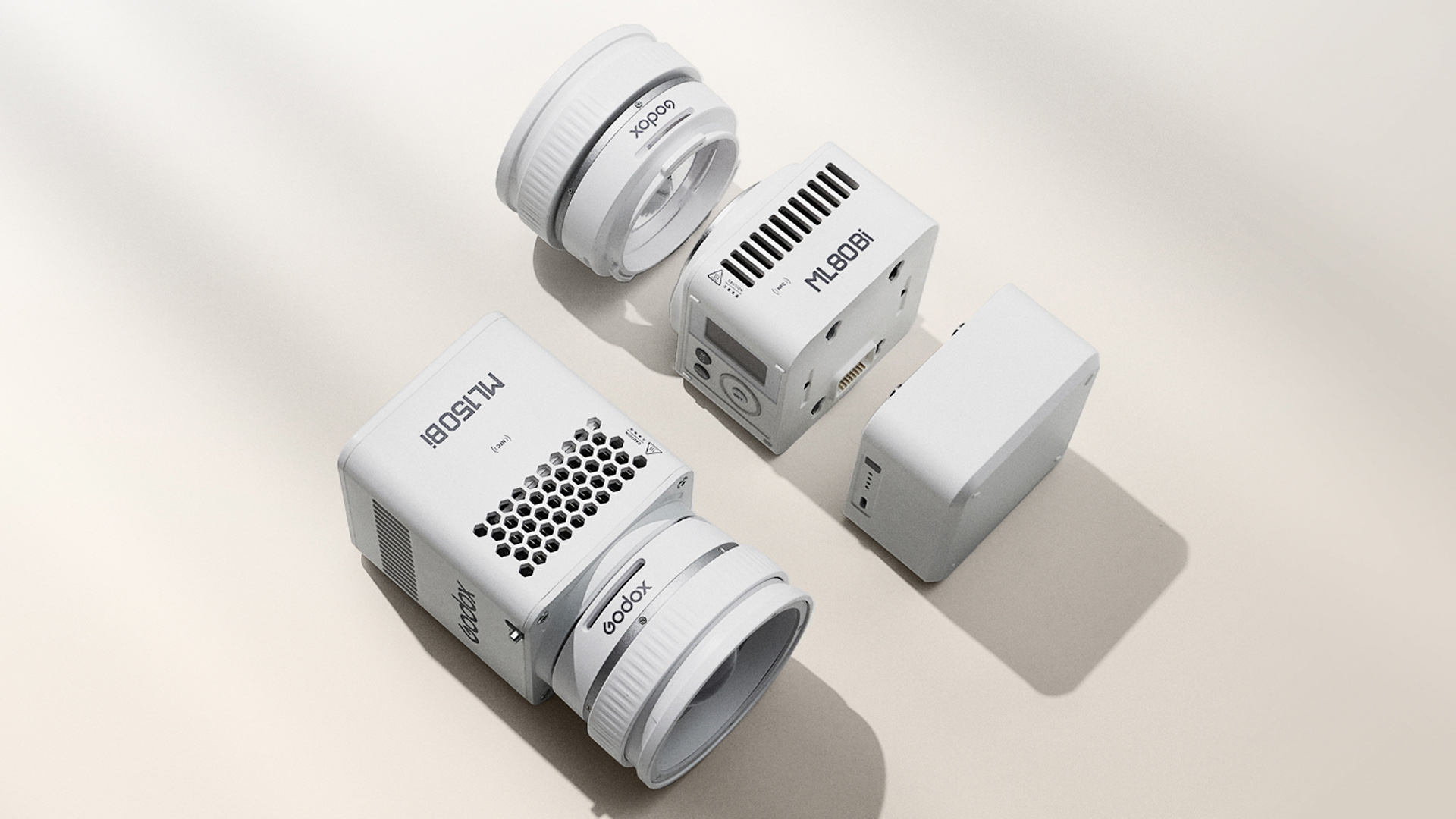About one-third of patients with focal epilepsy, a common form of the neurological disorder, are believed to respond poorly to available therapies. Yet they, too, may eventually see improvement, if not total relief, from their seizures, a…
Blog
-

Godox ML80Bi / ML150Bi Bi-Color LED Video Lights Introduced – High Output and Adaptable
Godox is introducing two compact bi-color LED lights, the ML80Bi and ML150Bi, to their lineup of video lighting tools. Both lights use a modular system that adapts to different power and accessory setups, making them versatile and practical for…
Continue Reading
-

Samsung Launches “Summer Is On Us” Campaign — Get More with Every Big-Screen Purchase – Samsung Newsroom South Africa
Samsung is turning up the heat this summer with its exciting Summer Is On Us campaign – a celebration of big screens, bold entertainment, and even bigger rewards. From 20 October 2025 to 25…
Continue Reading
-
The Sky Today on Tuesday, October 21: The Orionids peak, Comet Lemmon is closest to Earth, and Titan makes a transit – Astronomy Magazine
- The Sky Today on Tuesday, October 21: The Orionids peak, Comet Lemmon is closest to Earth, and Titan makes a transit Astronomy Magazine
- Viewing the Orionid Meteor Shower in 2025 American Meteor Society
- STARCAST: A Lemmon, SWAN, and meteor shower,…
Continue Reading
-

The Draft! review – entertaining Indonesian meta-horror goes down the Scream route | Film
If you enjoyed Scream and Cabin in the Woods, you’ll want to give this Indonesian horror a spin: it’s a gleefully referential slasher set not in a cabin in the woods, but a villa in the jungle. Said villa has no phone signal, but does benefit…
Continue Reading
-
2025 Capital Markets Day
Capital Markets Day Presentation on Wednesday, 3 December 2025
Glencore plc will host a Capital Markets Day presentation on Wednesday, 3 December 2025 at 1 pm UK.
Webcast
A live video webcast starting at 1 pm UK will be accessible at:
https://edge.media-server.com/mmc/p/dgm92n89To listen to the audio please make sure your speakers are unmuted on your computer or laptop. If you are using a mobile device please use your handset’s volume controls.
Presentation
The Capital Markets Day presentation slides will be available for download on 3 December 2025 from 12 pm UK time from our website.
Replay
If you are unable to attend the live video webcast, an on-demand replay will be available within 24 hours of the presentation ending at the same link as the live webcast. The presentation will also be archived on our website.
Continue Reading
-

C’est Comme Ça: How I Became a Cassoulet Champ
Justin Postlethwaite joins an epic gourmet celebration of cassoulet in Toulouse and becomes a world record holder.
In May, I was lucky enough to be…
Continue Reading
-

Prince Andrew tried to hire ‘internet trolls’ to hassle Virginia Giuffre, book claims – The Irish Times
Prince Andrew’s team tried to hire “internet trolls to hassle” his accuser, Virginia Giuffre, while he hid behind the “well-guarded gates” of Balmoral Castle to avoid being served court papers, according to allegations in her posthumous…
Continue Reading
-

Enhancing childbirth experience: The synergistic effects of free posit
Introduction
Natural childbirth is widely recognized as a relatively safe delivery method for mothers, offering faster postpartum recovery and effectively avoiding the short- and long-term complications associated with cesarean sections.1–3 However, the labor process for natural delivery is often prolonged, particularly for first-time mothers, and it is difficult to avoid pain caused by uterine contractions during labor. This pain not only impacts the delivery process but may also pose certain risks to maternal and neonatal safety.4–6 Labor pain, one of the primary physiological challenges faced by mothers during childbirth, primarily stems from uterine contractions, cervical dilation, and pressure on the birth canal. Such pain can trigger significant psychological stress in mothers, potentially reducing the efficiency of contractions, prolonging labor duration, and consequently increasing the likelihood of cesarean delivery and other complications.7–9 Although traditional supine delivery facilitates medical monitoring, it has been associated with potential disadvantages, including increased reports of maternal discomfort, compromised hemodynamics (eg, supine hypotensive syndrome), and potential narrowing of the pelvic outlet compared to upright positions, potentially exacerbating maternal discomfort and hindering fetal descent.10–12
In recent years, non-pharmacological interventions have gained increasing attention in obstetric research and clinical practice as part of a broader movement towards humanized childbirth care.13 Studies have shown that evidence-based, woman-centered labor care not only facilitates smoother delivery but also effectively reduces the risk of adverse outcomes.14,15 Among these interventions, free positioning and mindful relaxation techniques have garnered significant attention for their role in supporting the delivery process. Free positioning during labor transcends the limitations of traditional supine delivery, allowing mothers to choose positions such as standing, squatting, kneeling, or lying on their sides according to their needs and comfort. This autonomy in movement is thought to optimize the pelvic angle (potentially increasing the anteroposterior diameter), facilitate the descent and rotation of the fetus by utilizing gravity, and may reduce soft tissue resistance, thereby potentially reducing delivery difficulties and associated pain.16–18 However, widespread implementation of free positioning faces challenges, including staff training requirements, resource constraints (eg, availability of birthing aids like balls or stools), and adherence to conventional protocols in some settings.14,19 Meanwhile, mindful relaxation techniques (MRTs), often rooted in Mindfulness-Based Stress Reduction (MBSR) principles adapted for childbirth, involve deliberate attention regulation, non-judgmental awareness of present-moment sensations (including pain), breathing regulation, progressive muscle relaxation, and positive emotional guidance.20,21 The core aim of MRTs is to help mothers modulate their psychological and physiological stress responses, thereby reducing the affective and cognitive components of pain perception, alleviating anxiety, and enhancing their overall sense of control and childbirth experience.22,23 Despite documented benefits, the integration of structured MRTs into routine antenatal education and intrapartum care remains variable and is not yet standard practice globally.24,25
Although previous studies have separately explored the roles of free positioning and mindful relaxation techniques in childbirth, rigorous research evaluating their combined application in natural delivery remains notably scarce. Systematic reviews highlight the independent benefits but lack robust evidence on synergistic effects.26,27 Considering the complementary physiological and psychological effects of these two approaches, a synergistic interaction is theoretically plausible: free positioning primarily addresses biomechanical factors and physiological pain pathways (eg, optimizing fetal position and reducing soft tissue strain), while MRTs target the psychological and neurocognitive aspects of pain processing (eg, reducing fear-tension-pain cycles and enhancing pain coping mechanisms).28,29 This combined approach may lead to greater overall pain reduction and labor efficiency than either intervention alone. Therefore, this study aims to examine the combined intervention’s efficacy in alleviating labor pain and shortening labor duration, thereby providing a basis for further optimization of obstetric care strategies. This investigation is particularly relevant within our institutional context in China, where there is a growing national emphasis on promoting natural childbirth and enhancing maternal satisfaction within the healthcare system,30 yet barriers to implementing comprehensive non-pharmacological approaches persist.
Subjects and Methods
Study Subjects
Study Design and Ethical Considerations
This retrospective cohort study included pregnant women who delivered at Wuxi Second People’s Hospital between August 2023 and October 2024. The study was approved by the Ethics Committee of Wuxi Second People’s Hospital (Approval No.: 2022–081) and conducted in accordance with the 1964 Helsinki Declaration and its later amendments. Due to the retrospective nature of the study, the requirement for informed consent was waived by the IRB. Data collection employed an “opt-out” method, consistent with national regulations and ethical standards for minimal-risk retrospective research using anonymized data. Potential participants were informed about the study via hospital noticeboards and electronic platforms; those declining participation within two weeks were excluded. No objections were registered.
All collected data were strictly confidential and anonymized before analysis to protect participants’ privacy. Access to the data was limited to authorized research personnel only, and all data handling complied with institutional and national data protection regulations to ensure data security throughout the study.
Participants
After screening electronic medical records against predefined criteria, a total of 120 eligible participants were identified and included in the analysis. Participants were categorized into two groups based on the documented care received during delivery: the research group (n = 60), who received the combined intervention of free positioning and mindful relaxation techniques, and the Control Group (n = 60), who received routine delivery care.
Inclusion and Exclusion Criteria
Inclusion Criteria
Participants were required to meet the following criteria:
Singleton pregnancy at full-term gestation;
No absolute indications for cesarean delivery and the ability to undergo natural childbirth;
Availability of complete and traceable clinical records;
Normal communication abilities and clear consciousness.
Exclusion Criteria
Participants were excluded if they met any of the following conditions:
Presence of pregnancy complications such as hypertensive disorders of pregnancy or gestational diabetes;
High-risk pregnancies, including advanced maternal age or multiple pregnancies;
Abnormal pelvic structure or birth canal deformities;
Coagulation disorders or cognitive impairments;
Concurrent cardiac, pulmonary, or other major organ dysfunction.
Interventions
Control Group: Routine Delivery Care
Participants received standard obstetric care per hospital protocol. This included continuous fetal heart rate monitoring and assessment of cervical dilation. Upon reaching active labor (cervix dilated ≥3 cm), participants were transferred to the delivery room. Midwives provided continuous presence and support. Participants were typically guided to adopt supine or semi-recumbent positions as labor progressed and were instructed on breathing and pushing techniques during the second stage. Psychological support included verbal encouragement and physical reassurance (eg, hand-holding, gentle stroking).
Research Group: Combined Intervention (Free Positioning + Mindful Relaxation)
Midwives delivering this intervention had completed a standardized 40-hour training program covering: 1) Theory and evidence for free positioning and mindful relaxation; 2) Practical demonstration and supervised practice of all positions and mindfulness techniques; 3) Communication skills for guiding women; and 4) Documentation requirements. Training was based on WHO recommendations22 and FIGO guidelines.31
Free Positioning: During the active phase of labor (cervical dilation ≥3 cm), midwives introduced and demonstrated a variety of labor positions to the participants. Women were encouraged to move freely and select positions based on their comfort and individual preference, with midwives providing support and assistance for any necessary position changes. Commonly adopted positions included: recumbent positions (semi-recumbent, right lateral, and left lateral), standing positions (standing upright beside the bed while holding onto support), sitting positions (seated on the delivery bed or a low stool with hands supporting and body slightly leaning back), squatting positions (feet apart, supported by holding onto a chair or bed edge, often with midwife assistance), and kneeling positions (kneeling on a soft mat with knees apart and leaning forward on a pillow or blanket). There were no fixed time requirements for any specific posture; changes in position occurred as frequently as desired by the woman or in response to discomfort, allowing for a flexible, real-world application of the intervention.
Mindful Relaxation Techniques (MRTs): Upon admission to the delivery room (with cervical dilation ≥3 cm), guided mindful relaxation sessions were initiated and offered continuously throughout labor, particularly during contractions. Each session typically lasted 10–20 minutes and was flexibly adjusted to align with the pattern of uterine contractions and the participant’s level of concentration. While maintaining a self-selected labor position, participants were guided by midwives through a structured mindfulness protocol. This included sensory focus, wherein women were provided with a real object (such as an apple or orange) and instructed to observe its color, shape, and texture, touch its surface, and appreciate its aroma. This was followed by internalization, where they were guided to close their eyes, mentally recall the object’s characteristics, and focus attention while clearing the mind of distractions. A calm ambiance was created using continuous instrumental music played at a moderate volume (40–60 dB). During guided imagery, participants were encouraged to use their imagination to mentally explore the object in greater detail, promoting immersive concentration. In the breath regulation phase, midwives guided a transition from shallow, rapid breathing to deep, steady diaphragmatic breathing, synchronized with silent counting from one to ten and back. Finally, in the reflection stage, participants were instructed to open their eyes, then close them again to recall and verbalize their experience. This protocol, adapted from Mindfulness-Based Childbirth and Parenting (MBCP) principles,32 aimed to alleviate maternal stress, enhance emotional and physical relaxation, and improve women’s coping with labor pain.
Observation Indicators
In this retrospective cohort study, all observation indicators were extracted from standardized medical and nursing records. To reduce bias arising from inconsistent data collection, especially for subjective measures (eg, pain or psychological states), only data recorded by trained staff using standardized tools during the clinical process were included. Records with missing or retrospectively added assessments were excluded to enhance data reliability. The specific indicators evaluated were as follows:
Duration of Labor
Labor duration was segmented into the first, second, and third stages, with total labor time subsequently calculated. These data were obtained from partogram records maintained by midwives in real time during delivery. Comparative analysis was conducted between the intervention and control groups to evaluate differences in labor progression.
Pain Levels
Pain intensity during labor was evaluated using a multidimensional framework based on the Verbal Rating Scale (VRS) recommended by the World Health Organization in 1980. This included three components: (1) the VRS, which classifies pain into four levels—0 (no pain), 1 (mild pain that does not interfere with sleep or daily life), 2 (moderate pain requiring non-narcotic interventions), and 3 (severe pain requiring narcotic analgesia and often accompanied by autonomic symptoms); (2) the Pain Rating Index (PRI), consisting of 15 descriptors, each rated from 0 to 3 (no, mild, moderate, or severe pain), with higher scores indicating greater overall pain perception; and (3) the Visual Analogue Scale (VAS), a 10-cm horizontal ruler labeled from 0 (no pain) to 10 (worst imaginable pain), where participants marked the intensity of their pain. Only assessments recorded by midwives during labor were included in the analysis.
Perineal Tears
The degree of perineal trauma was classified based on clinical records according to standard obstetric grading criteria. These included: intact perineum (no laceration), Grade I (superficial tears of the vaginal or perineal mucosa), Grade II (tears involving the perineal muscle layer and/or posterior vaginal wall), Grade III (tears extending to the external anal sphincter), and Grade IV (full-thickness tears involving the rectal mucosa). Grading was performed by attending midwives or obstetricians immediately postpartum and documented in delivery notes.
Sense of Labor Control
Maternal sense of control during childbirth was measured using the Labor Agentry Scale (LAS), which comprises 29 items rated on a 7-point Likert scale, yielding a total score between 29 and 203. Higher scores represent greater perceived control and agency during labor. In this retrospective analysis, only LAS questionnaires completed within two hours postpartum and documented in full by trained staff were considered valid.
Negative Emotions
Psychological states, specifically anxiety and depression, were assessed using the Self-Rating Anxiety Scale (SAS) and the Self-Rating Depression Scale (SDS), respectively. Each scale includes 20 items rated on a 4-point scale, with a total score of 80. Higher scores indicate more severe emotional distress. In order to ensure consistency, only data collected at standardized time points (within one week before intervention and within 30 minutes postpartum) and documented under supervision were included in the analysis.
Pregnancy Outcomes
Pregnancy outcomes were assessed by recording postpartum hemorrhage volume within two hours of delivery and evaluating neonatal health using the Apgar scoring system. The Apgar score includes five parameters—skin color, heart rate, respiratory effort, muscle tone, and reflex response—each rated from 0 to 2, with a maximum total of 10. Scores were categorized as 10 (optimal condition), 7–9 (mild concerns), or <7 (requires immediate intervention). These scores were extracted from standardized neonatal assessment forms filled by neonatal nurses or pediatricians at 1 and 5 minutes after birth.
Data Analysis
A priori sample size calculation was performed using G*Power 3.1.25 Based on pilot data (unpublished) and previous studies,6,18 a medium effect size (Cohen’s d = 0.65) for the primary outcome (pain VAS score) was assumed. To achieve 80% power (α=0.05, two-tailed t-test), 60 participants per group were required. This justified the final sample size of n=120 (60 per group).
GraphPad Prism 8 was used for graphical presentation. SPSS 26.0 was used for statistical analysis. Quantitative data were assessed for normality using the Shapiro–Wilk test and visual inspection of Q-Q plots. Normally distributed data are presented as Mean ± Standard Deviation (SD) and compared using Independent Samples t-tests. Non-normally distributed data are presented as Median (Interquartile Range, IQR) and compared using Mann–Whitney U-tests. Qualitative data are presented as Number (Percentage, %) and compared using Chi-square (χ²) or Fisher’s exact test, as appropriate. Effect sizes are reported (Cohen’s d for t-tests, Cramer’s V for χ²). A two-tailed P value < 0.05 was considered statistically significant. No adjustments for multiple comparisons were made for secondary outcomes, consistent with exploratory analysis in this retrospective design; findings should be interpreted accordingly.
Results
Baseline Data
The control group included 60 participants, aged 25–35 years (Mean ± SD: 28.44 ± 2.63 years); gestational age 37–42 weeks (39.02 ± 0.94 weeks); body weight 50–78 kg (63.15 ± 6.22 kg).
The research group included 60 participants, aged 25–35 years (28.96 ± 2.58 years); gestational age 37–42 weeks (39.07 ± 1.02 weeks); body weight 50–78 kg (63.74 ± 6.18 kg).
No significant differences existed in baseline characteristics (P > 0.05, Table 1), confirming comparability.
Table 1 Comparison of Baseline Data Between the Two Groups (Mean ± SD)
Labor Duration
As shown in Figure 1, the research group exhibited significantly shorter labor durations across all three stages compared to the control group. Specifically, the mean duration of the first stage of labor was markedly reduced in the research group (240.69 ± 25.96 minutes) compared to the control group (362.47 ± 31.94 minutes), with a large effect size (Cohen’s d = 4.22, 95% CI: 112.15–131.41, p < 0.001). The second stage of labor was also significantly shorter in the research group (42.32 ± 10.69 minutes) versus the control group (52.14 ± 12.23 minutes), with a moderate to large effect size (Cohen’s d = 0.87, 95% CI: 6.29–13.35, p < 0.001). For the third stage, the research group showed a mean duration of 5.11 ± 2.56 minutes, significantly less than the control group’s 8.74 ± 2.85 minutes (Cohen’s d = 1.35, 95% CI: 2.78–4.48, p < 0.001). Overall, the total labor duration was significantly reduced by approximately 135 minutes in the research group (291.23 ± 28.65 minutes) compared to the control group (426.56 ± 40.69 minutes), with a large effect size (Cohen’s d = 3.86, 95% CI: 121.30–149.36, p < 0.001).

Figure 1 Comparison of Labor Duration Between the Two Groups.
Note: *Indicates P < 0.05 compared to the control group.
Pain Levels
As shown in Figure 2, pain levels following the intervention were significantly lower in the research group across all assessment dimensions. On the Visual Analog Scale (VAS), the research group reported a mean score of 4.32 ± 1.03, significantly lower than the control group’s 5.23 ± 1.24 (Cohen’s d = 0.80, 95% CI: 0.65–1.17, p < 0.001), indicating a moderate to large effect size. Similarly, the Pain Rating Index (PRI) scores were reduced in the research group (2.49 ± 0.45) compared to the control group (2.94 ± 0.78), with a moderate effect size (Cohen’s d = 0.71, 95% CI: 0.28–0.62, p < 0.001). In terms of Present Pain Intensity (PPI), the research group scored 25.45 ± 2.14, significantly lower than the control group’s 28.77 ± 2.56 (Cohen’s d = 1.42, 95% CI: 2.67–3.97, p < 0.001), reflecting a large effect size. These findings indicate that the combined intervention of free positioning and mindful relaxation techniques was effective in significantly alleviating both the sensory and cognitive-affective components of labor pain.

Figure 2 Comparison of VRS Scores Between the Two Groups.
Note: *Indicates a significant difference between the two groups, P<0.05.
Perineal Laceration
As illustrated in Figure 3, the distribution of perineal outcomes differed significantly between the two groups (P < 0.05). In the research group, 35.00% (21/60) of participants had an intact perineum, 41.67% (25/60) experienced Grade I lacerations, 21.67% (13/60) had Grade II lacerations, and 1.67% (1/60) sustained Grade III lacerations. In comparison, the control group showed 23.33% (14/60) with an intact perineum, 30.00% (18/60) with Grade I lacerations, 35.00% (21/60) with Grade II lacerations, and 11.67% (7/60) with Grade III lacerations. These findings indicate a higher proportion of intact perineum and first-degree lacerations but a lower incidence of more severe (Grade II and III) tears in the research group, suggesting a protective effect of the intervention on perineal outcomes.

Figure 3 Comparison of Perineal Laceration Degrees Between the Two Groups.
Note: *Indicates a significant difference between the two groups, P<0.05.
Labor Control
The analysis of Labor Agentry Scale (LAS) scores revealed a statistically significant difference between the two groups. Participants in the research group reported a higher sense of control during labor, with a mean LAS score of 152.41 ± 8.11, compared to 144.22 ± 9.11 in the control group (d = 0.95; 95% CI: 5.42–10.96; P < 0.001). This suggests that the combined intervention notably enhanced participants’ perceived autonomy and empowerment throughout the birthing process. See Table 2.

Table 2 Comparison of LAs Scores Between the Two Groups (Mean ± SD)
Negative Emotions
The analysis of post-intervention psychological outcomes indicated that participants in the research group experienced significantly lower levels of anxiety and depression compared to those in the control group. Specifically, the Self-Rating Anxiety Scale (SAS) scores were 46.23 ± 2.35 in the research group versus 55.98 ± 2.47 in the control group (t = 22.152, P < 0.001; d = 4.10; 95% CI: 8.99–10.23). Similarly, Self-Rating Depression Scale (SDS) scores were 45.22 ± 1.73 in the research group and 54.56 ± 2.14 in the control group (t = 26.291, P < 0.001; d = 4.71; 95% CI: 8.63–10.06). These findings suggest that the combined intervention was highly effective in reducing negative emotional responses during labor. See Table 3.

Table 3 Comparison of Anxiety and Depression Scores Between the Two Groups (
 )
)Pregnancy Outcomes
Postpartum outcomes revealed significant differences between the two groups. The mean volume of bleeding within 2 hours postpartum was markedly lower in the research group (155.89 ± 22.21 mL) compared to the control group (204.58 ± 30.88 mL), indicating improved hemostatic outcomes (d = 1.79; 95% CI: 40.65–57.59; P < 0.001). Apgar scores were slightly higher in the research group (8.44 ± 1.56) compared to the control group (8.05 ± 1.11); however, the difference was not statistically significant (d = 0.28; 95% CI: 0.13–0.73; P = 0.145), indicating comparable neonatal conditions between groups. See Figure 4.

Figure 4 Comparison of Postpartum 2-Hour Blood Loss and Neonatal Apgar Scores Between the Two Groups.
Note: *Indicates a significant difference between the two groups, P<0.05.
Discussion
This study aimed to evaluate the effects of free positioning combined with mindfulness relaxation techniques on labor pain relief and labor duration reduction. The results showed that this combined intervention significantly shortened the duration of each stage of labor, alleviated labor pain, improved maternal sense of control and emotional status during labor, and reduced postpartum blood loss, demonstrating favorable clinical outcomes. These findings are consistent with multiple previous studies, further validating the value of this integrated intervention model in promoting natural childbirth.
Firstly, the significant shortening of labor duration is one of the core findings of this study. The intervention group’s average duration of the first stage of labor was markedly shorter than that of the control group (240.69 minutes vs 362.47 minutes), with an overall labor time reduction of approximately 135 minutes and a very large effect size (Cohen’s d = 3.86). This result aligns with the conclusions of Mansfield et al’s systematic review on free positioning facilitating labor progress, which indicated that freedom of movement and position changes could reduce the risk of prolonged cervical dilation and extended second stage of labor.33 The mechanism may be related to multiple factors: free positioning allows the mother to utilize gravity to assist fetal descent, relieve pressure on the birth canal during uterine contractions, facilitate better alignment of the fetal head with the birth canal curve, and reduce birth canal resistance.34 Moreover, alternating between different positions can improve pelvic morphology and blood circulation, helping relax the pelvic floor muscles and thus accelerating labor.35
In addition, the effect of mindfulness relaxation in alleviating labor pain and improving emotional state may also partly be attributed to the potential regulation of the neuroendocrine system. Although this study did not directly measure neuroendocrine-related indicators, existing literature shows that mindfulness interventions can reduce sympathetic nervous system activity, enhance parasympathetic tone, and regulate the hypothalamic-pituitary-adrenal (HPA) axis reactivity, thereby decreasing the secretion of stress hormones such as cortisol and norepinephrine.36–38 This neuroendocrine balance adjustment helps lower pain sensitivity, relieve anxiety and tension, increase pain threshold, and enhance maternal sense of control and adaptability during labor. In this study, women in the intervention group performed better in subjective pain scores (VAS, PPI, etc)., anxiety and depression scales (SAS/SDS), and labor control scores (LAS), indirectly supporting the plausibility of this mechanism. This dual physiological–psychological pathway suggests that the combined intervention of free positioning and mindfulness relaxation not only improves clinical outcomes but may also have favorable neuroregulatory and mind-body synergistic effects, warranting further exploration at the physiological mechanism level.
Simultaneously, the intervention group showed a significantly enhanced sense of labor control (LAS scores significantly higher than control), indicating that this intervention model improved maternal autonomy and self-efficacy. A high sense of control during labor is closely related to reduced labor anxiety, decreased frequency of obstetric interventions, and promotion of vaginal delivery.39 This is because free positioning and mindfulness relaxation allow mothers to actively choose comfortable postures and psychological adjustment methods, increasing their mastery over the delivery process and reducing fear and helplessness.40 This result is also supported by studies by Li and Guo, who reported that psychological support and self-regulation strategies during labor significantly improve maternal delivery satisfaction and psychological health.41,42
This study also observed a significantly lower incidence of severe perineal lacerations (grade II and above) and a notable reduction in postpartum blood loss in the intervention group. Free positioning (eg, semi-sitting, lateral, squatting) can reduce perineal tension, promote natural soft tissue expansion, and decrease the risk of mechanical injury.43 Mindfulness relaxation may contribute by lowering stress responses, improving vascular tone and tissue perfusion, thereby facilitating local repair and hemostasis.44 These findings are consistent with Hughes’ review on perineal protection strategies, which emphasizes the importance of posture adjustment and emotional interventions in reducing perineal trauma and postpartum hemorrhage.45
In summary, this study confirms that free positioning combined with mindfulness relaxation techniques significantly promotes labor pain relief, shortens labor duration, reduces perineal trauma, and improves maternal psychological state. The mechanisms involve physiological and mechanical optimization (such as fetal descent and pelvic morphology changes), neuroendocrine regulation (reduced sympathetic excitation and enhanced analgesia), and psychological-behavioral enhancement of labor control. The synergy of these mechanisms improves the overall childbirth experience and facilitates smooth natural delivery.
Limitations
Although the results show that free positioning combined with mindfulness relaxation techniques have positive effects on labor pain relief, labor duration reduction, emotional improvement, and childbirth experience enhancement, several limitations should be fully considered when interpreting the findings. First, this study is a retrospective cohort design and is limited by the completeness and accuracy of existing medical records, which may introduce information and recall bias. Since randomization and blinding were not performed, there may be uncontrolled baseline differences and selection bias between the intervention and control groups, affecting the rigor of causal inference. Moreover, potential confounders such as maternal social support, fear of childbirth, experience level of birth attendants, and fetal position were not fully controlled, which could partially interfere with the assessment of intervention effects.
Second, the sample size is relatively small and drawn from a single center, which may affect the representativeness and generalizability of the results. Future studies should validate these findings through multicenter, large-sample, prospective randomized controlled trials to strengthen external validity and causal inference. Additionally, as this study did not include single free positioning or single mindfulness intervention groups, it cannot clearly evaluate the independent contribution of each component nor conclude whether true synergistic effects exist. Therefore, the term “combined intervention effect” should be used cautiously to indicate superior effects compared with routine care but not to prove interaction between interventions.
Finally, although literature suggests that mindfulness interventions may exert effects via neuroendocrine regulation—such as reducing sympathetic activity, modulating the HPA axis, and decreasing stress hormone secretion36–38—this study did not directly measure neuroendocrine markers, so these remain hypothetical explanations that need further mechanistic research to validate their biological basis.
Conclusion
The results of this study preliminarily suggest that free positioning combined with mindfulness relaxation interventions may help shorten labor duration, relieve labor pain, improve emotional state, and enhance maternal sense of control during childbirth, thereby promoting smooth natural delivery. This non-pharmacological, low-cost intervention model has certain potential for clinical promotion, especially in resource-limited or humanized childbirth-focused settings.
However, given the retrospective design, lack of randomization, blinding, and long-term follow-up, causal interpretations should be cautious. Additionally, the synergistic effects of the combined intervention cannot be separated to clarify individual components’ independent effects. Future research should employ more rigorous prospective randomized controlled trials or factorial design studies to further elucidate intervention mechanisms and explore applicability and sustainability across different populations and labor stages.
In summary, the current findings provide valuable preliminary evidence supporting non-pharmacological interventions to promote natural childbirth, warranting further exploration and validation in higher-quality studies to assess feasibility and effectiveness for broader application.
Disclosure
The authors report no conflicts of interest in this work.
References
1. Michalska A, Niechcial K, Niechcial R, et al. Natural childbirth and cesarean section – descriptive analysis of queries in Google search engine. Ginekol Pol. 2024;95(7):565–572. doi:10.5603/gpl.97654
2. Sharma S, Dhakal I. Cesarean vs Vaginal Delivery: an Institutional Experience. J Nepal Med Assoc. 2018;56(209):535–539. doi:10.31729/jnma.3467
3. Cosans C. The meaning of natural childbirth. Perspect Biol Med. 2004;47(2):266–272. doi:10.1353/pbm.2004.0022
4. Buxton IL, Crow W, Mathew SO. Regulation of uterine contraction: mechanisms in preterm labor. AACN Clin Issues. 2000;11(2):271–282. doi:10.1097/00044067-200005000-00010
5. Palomar Morales M, Hicks JJ. [Uterine contraction. Mechanism, regulation and pharmacology]. Ginecol Obstet Mex. 1990;58:303–309.
6. Huang B, Lu Y, Zhang Y, et al. Application of natural shoulder delivery combined with free position delivery in maternal delivery. Am J Transl Res. 2021;13(12):14168–14175.
7. Guo H, Que M, Shen J, et al. Effect of music therapy combined with free position delivery on labor pain and birth outcomes. Appl Bionics Biomech. 2022;2022:8963656. doi:10.1155/2022/8963656
8. Hanson L, Verklan T, Bakewell-Sachs S. Pertinent to intrapartum nursing. J Perinat Neonatal Nurs. 2014;28(2):89–90. doi:10.1097/JPN.0000000000000036
9. Anderson G, Zega M, D’Agostino F, et al. Meta-synthesis of the needs of women cared for by midwives during childbirth in hospitals. J Obstet Gynecol Neonatal Nurs. 2021;50(1):6–19. doi:10.1016/j.jogn.2020.10.005
10. Granger S. Hypnotherapy for childbirth. Pract Midwife. 2012;15(8):S13–4.
11. Oakley S, Evans E. The role of yoga: breathing, meditation and optimal fetal positioning. Pract Midwife. 2014;17(5):30–32.
12. Orme-Johnson D. Medical care utilization and the transcendental meditation program. Psychosom Med. 1987;49(5):493–507. doi:10.1097/00006842-198709000-00006
13. Domínguez-Solís E, Lima-Serrano M, Lima-Rodríguez JS. Non-pharmacological interventions to reduce anxiety in pregnancy, labour and postpartum: a systematic review. Midwifery. 2021;102:103126. doi:10.1016/j.midw.2021.103126
14. Thomson G, Feeley C, Moran VH, Downe S, Oladapo OT. Women’s experiences of pharmacological and non-pharmacological pain relief methods for labour and childbirth: a qualitative systematic review. Reprod Health. 2019;16(1):71. doi:10.1186/s12978-019-0735-4
15. Davis J. Effective non-pharmacological birth interventions. Pract Midwife. 2015;18(2):13–17.
16. Zeidan F, Vago DR. Mindfulness meditation–based pain relief: a mechanistic account. Ann NY Acad Sci. 2016;1373(1):114–127. doi:10.1111/nyas.13153
17. Zeidan F, Emerson NM, Farris SR, et al. Mindfulness meditation-based pain relief employs different neural mechanisms than placebo and sham mindfulness meditation-induced analgesia. J Neurosci. 2015;35(46):15307–15325. doi:10.1523/JNEUROSCI.2542-15.2015
18. Zeidan F, Adler-Neal AL, Wells RE, et al. Mindfulness-meditation-based pain relief is not mediated by endogenous opioids. J Neurosci. 2016;36(11):3391–3397. doi:10.1523/JNEUROSCI.4328-15.2016
19. Wang R, Lu J, Chow KM. Effectiveness of mind–body interventions in labour pain management during normal delivery: a systematic review and meta-analysis. Int J Nurs Studies. 2024;158:104858. doi:10.1016/j.ijnurstu.2024.104858
20. Smith CA, Levett KM, Collins CT, Dahlen HG, Ee CC, Suganuma M. Massage, reflexology and other manual methods for pain management in labour. Cochrane Database Syst Rev. 2018;2018(3). doi:10.1002/14651858.CD009290.pub3
21. Smith CA, Levett KM, Collins CT, Armour M, Dahlen HG, Suganuma M. Relaxation techniques for pain management in labour. Cochrane Database Syst Rev. 2018;2018(3). doi:10.1002/14651858.CD009514.pub2
22. Organization WH. WHO recommendations on intrapartum care for a positive childbirth experience: World Health Organization; 2018.
23. Orellana-Rios CL, Radbruch L, Kern M, et al. Mindfulness and compassion-oriented practices at work reduce distress and enhance self-care of palliative care teams: a mixed-method evaluation of an “on the job” program. BMC Palliative Care. 2017;17(1):3. doi:10.1186/s12904-017-0219-7
24. Mumtaz N, Tariq MZ, Ali A, et al. Impact of relaxation techniques on anxiety and pain management during labor: a quasi-experimental study. Pak-Euro J Med Life Sci. 2024;7(3):475–482.
25. Kabat-Zinn J. An outpatient program in behavioral medicine for chronic pain patients based on the practice of mindfulness meditation: theoretical considerations and preliminary results. General Hospital Psychiatry. 1982;4(1):33–47. doi:10.1016/0163-8343(82)90026-3
26. Duncan LG, Cohn MA, Chao MT, Cook JG, Riccobono J, Bardacke N. Benefits of preparing for childbirth with mindfulness training: a randomized controlled trial with active comparison. BMC Pregnancy Childbirth. 2017;17(1):140. doi:10.1186/s12884-017-1319-3
27. Başgöl Ş, Koç E. Non-pharmacological techniques in labor pain management. Samsun Saglik Bilimleri Dergisi. 2020;5(1):1–5.
28. Bartlett L, Martin A, Neil AL, et al. A systematic review and meta-analysis of workplace mindfulness training randomized controlled trials. J Occup Health Psychol. 2019;24(1):108. doi:10.1037/ocp0000146
29. Sandiford R. Keeping it natural. Nurs Times. 2006;102(3):22–23.
30. Young D. What is normal childbirth and do we need more statements about it? Birth. 2009;36(1):1–3. doi:10.1111/j.1523-536X.2008.00306.x
31. Ayres-de-Campos D, Spong CY, Chandraharan E. FIGO intrapartum fetal monitoring expert consensus panel. FIGO consensus guidelines on intrapartum fetal monitoring: cardiotocography. Int J Gynaecol Obstet. 2015;131(1):13–24. doi:10.1016/j.ijgo.2015.06.020
32. Zhang D, Tsang KW, Duncan LG, et al. Effects of the Mindfulness-Based Childbirth and Parenting (MBCP) program among pregnant women: a randomized controlled trial. Mindfulness. 2023;14(1):50–65. doi:10.1007/s12671-022-02046-8
33. Mansfield B. The social nature of natural childbirth. Soc Sci Med. 2008;66(5):1084–1094. doi:10.1016/j.socscimed.2007.11.025
34. Azizmohammadi S, Azizmohammadi S. Hypnotherapy in management of delivery pain: a review. Eur J Transl Myol. 2019;29(3):8365. doi:10.4081/ejtm.2019.8365
35. Evans MI, Britt DW, Worth J, et al. Uterine contraction frequency in the last hour of labor: how many contractions are too many? J Matern Fetal Neonatal Med. 2022;35(25):8698–8705. doi:10.1080/14767058.2021.1998893
36. Vargas-Uricoechea H, Castellanos-Pinedo A, Urrego-Noguera K, et al. Mindfulness-based interventions and the hypothalamic–pituitary–adrenal axis: a systematic review. Neurol Int. 2024;16(6):1552–1584. doi:10.3390/neurolint16060115
37. Ring HZ, Kern RJH. Zen meditation and the neuro-immuno-endocrine axis. Health. 2024;16(12):1242–1249. doi:10.4236/health.2024.1612086
38. Pascoe MC, Thompson DR, Ski CF. Metabolism: meditation and endocrine health and wellbeing. Trends Endocrinol Metab. 2020;31(7):469–477. doi:10.1016/j.tem.2020.01.012
39. Peternelj-Taylor C. Pregnancy, childbirth, and mothering: a forensic nursing response. J Forensic Nurs. 2008;4(2):53–54. doi:10.1111/j.1939-3938.2008.00009.x
40. Ayers S. Fear of childbirth, postnatal post-traumatic stress disorder and midwifery care. Midwifery. 2014;30(2):145–148. doi:10.1016/j.midw.2013.12.001
41. Li L, Zhang P, Qin Z, et al. The effect of holographic Meridian scraping therapy combined with free position on the labor process, perineum lateral resection rate, and delivery outcomes of primiparae. Am J Transl Res. 2021;13(8):9846–9852.
42. Guo L, Chen L, Jiao Y, et al. Analysis of the effect of free position delivery on the success rate and safety of vaginal trial delivery in patients with scar uterine vaginal delivery. Panminerva Med. 2022;64(4):574–576. doi:10.23736/S0031-0808.21.04478-5
43. Dénakpo J, Lokossou A, Tonato-Bagnan JA, et al. [Delivery in free position perhaps a solution to change delivery in traditional position in delivery rooms in Africa: results of a prospective study in Cotonou in Bénin]. J Obstet Gynaecol Can. 2012;34(10):947–953. doi:10.1016/S1701-2163(16)35408-1
44. Veringa-Skiba IK, Ziemer K, de Bruin EI, et al. Mindful awareness as a mechanism of change for natural childbirth in pregnant women with high fear of childbirth: a randomised controlled trial. BMC Pregnancy Childbirth. 2022;22(1):47. doi:10.1186/s12884-022-04380-0
45. Hughes A, Williams M, Bardacke N, et al. Mindfulness approaches to childbirth and parenting. Br J Midwifery. 2009;17(10):630–635. doi:10.12968/bjom.2009.17.10.44470
Continue Reading
-

Chaman Border Crossing Partially Reopens After Pak-Afghan Ceasefire
Afghan refugees board into trucks as they prepare to leave for their homeland through a border crossing point which partially opens following Pakistan Afghanistan ceasefire truce, at a camp in Chaman, a border town on the Pakistan Afghan border,…
Continue Reading
